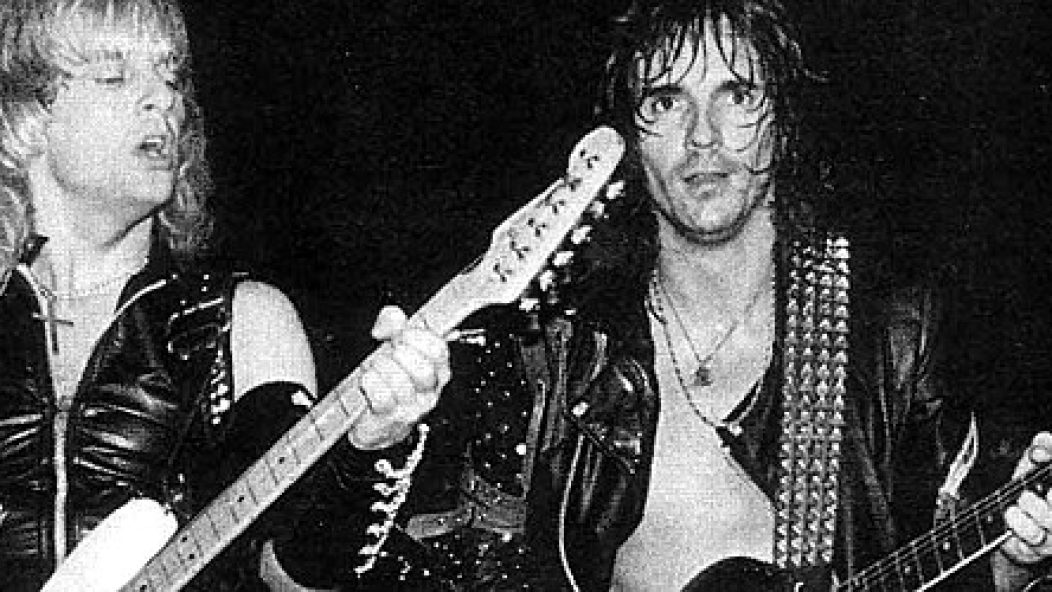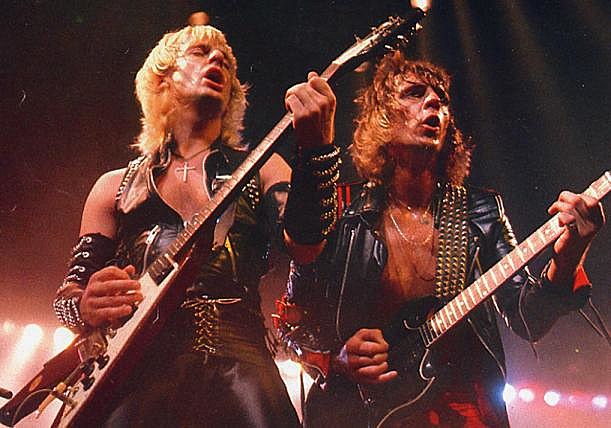
Top 10 Metal Twin Axe Attacks

. . .
K.K. Downing’s recent departure from Judas Priest stunned fans, partly because it left the band out to dry before its final tour. That’s so brazen, it’s almost admirable. (“Work sucks! I think I’ll just leave!”) But what really has fans upset is the fact that they won’t see Downing and Tipton do synchronized guitar dancing again. That’s a huge part of Priest’s identity. I can’t imagine any other dude doing it alongside Tipton without it seeming forced.
This got me thinking about other twin axe attacks. Classic rock is full of great guitar duos. Young – Young, Richards – Wood, Whitford – Perry, Slash – Stradlin, Allman – Betts: the list goes on. Metal guitar duos, staples of ’80s metal, are also big parts of my musical background. The art of the rhythm-lead guitar dynamic has mostly been lost, partly due to the advent of extreme metal. Death metal shifted the focus away from guitarists towards drummers. Black metal, to an extent, shifted the focus away from instrumentalists to other concerns. It’s rare now to hear a metal guitar lead and actually remember it.
This list of the Top 10 Metal Twin Axe Attacks dovetails with many other potential lists – Top 10 Metal Rhythm Guitarists, Top 10 Metal Guitar Harmonies, Top 10 Metal Albums with Stereo Separated Guitars. I love it when two guitarists exceed the sum of their parts. Here are 10 such pairs. I’ve left out many, of course. Who are your favorite twin axe attacks?
. . .
TOP 10 METAL TWIN AXE ATTACKS
. . .
10. Gant – Cannavino (Overkill)
Overkill are a funny band. They are singer Bobby “Blitz” Ellsworth, bassist D.D. Verni, and whoever else is along for the ride. Thus, their sound has changed drastically as various guitarists have donned the green and black. I don’t know where Merritt Gant and Rob Cannavino came from, nor where they went. But they briefly took Overkill to the first tier with Horrorscope, which I maintain is one of the greatest metal records ever. Yes, their tenure was one of diminishing returns, but compared to Overkill directly before (solid but unspectacular power/speed metal) and after (spectacular awfulness) them, they were miracle workers.
. . .
9. Cavalera – Kisser (Sepultura)
This is another example of not knowing how good something is until it’s gone. After Max Cavalera left Sepultura, he and Sepultura guitarist Andreas Kisser both flailed musically, if not career-wise. Cavalera has a new lead guitar foil in Marc Rizzo, but that interaction has mostly been “Roots riffs with unrelated shredding over them”. Meanwhile, I wonder if Kisser ever looks over at vocalist Derrick Green on stage and thinks, “Man, I miss Max’ guitar”. Cavalera, as the caveman rhythm guitarist, and Kisser, as the quirky lead guitarist, exceeded the sum of their parts. Chaos A.D. is loaded with guitars weaving unexpected and memorable textures. When I hear Cavalera Conspiracy and latter-day Sepultura, I can only shake my head.
. . .
8. Holt – Hunolt (Exodus)
Yes, they were the “H-Team”. But other than having rhyming names that began with “H”, what made Gary Holt and Rick Hunolt so special? I’m not sure, other than the obvious: they had bitchin’ riffs, and played them with verve and precision. As for their individual styles, I dunno – maybe veteran Exodus fans can explain the difference between Holt’s and Hunolt’s styles. The last record they did together, Tempo of the Damned, is an unappreciated rager. But Holt has done fine without Hunolt, arguably upgrading with Lee Altus of Heathen. I’m amazed that after three decades, Holt still has bitchin’ riffs left in him.
. . .
7. Skolnick – Peterson (Testament)
One of metal’s greatest ever soloists and one of metal’s greatest ever rhythm guitarists – what a pair. Testament were more about catchy, middle-of-the-road songs, so people haven’t focused on their guitarists that much. Sure, Skolnick was a guitar magazine favorite back in the day. But one doesn’t fully digest his awesome fluency on guitar until one sees him live. Talk about total control! And I could on and on about Eric Peterson’s riffs. You can hum them, you can remember them, and they’re big and heavy. At a Testament show, stage left and stage right both offer much to learn from.
. . .
Cacophony – “Black Cat” (live in Japan ’89)
. . .
6. Becker – Friedman (Cacophony)
When you mention Cacophony, you have to mention Racer X, too: bands who used feints at heavy metal as excuses for poodle-haired guitarists to rub wood dexterously and make o-faces. These bands are to blame for Dragonforce. But they were also so strange, they were almost cool. I’ve never actually heard a Racer X record; YouTube clips are plenty for me. As for Cacophony, I owned a copy of Go Off! once. I listened to it and thought, “That was interesting. I never want to hear that again”. For evidence of just how wacko Jason Becker and Marty Friedman were, see this live video of them from ’89. “Black Cat” starts with harmonies in Asian scales (accompanied by terrible o-faces), which yield to generic power metal and Bon Jovi tassels. About four minutes in, the song wakes back up with lightning-fast harmonized arpeggios, more terrible o-faces, and a circus music quote. Then come the tassels again. This is some insane, John Zorn/Mr. Bungle-gone-power-metal shit.
. . .
5. Mustaine – Friedman (Megadeth)
OK, back to the land of real music. Unlike Becker – Friedman, Mustaine – Friedman was not a comedic proposition (well, except for Risk). It was probably metal’s greatest yin-ying combination ever – Dave Mustaine’s bluesy mania vs. Marty Friedman’s suave, tasty licks. (It’s hard to talk about guitar shredding without sounding homoerotic.) Pairs like this are why individual solo credits in liner notes were invented. The Mustaine – Friedman dynamic was most evident in the tradeoff solos in “Hangar 18”. Two musical personalities going head-to-head, and it’s obvious who’s who. What bands now have such discernible identities? The individual is a dying breed in metal.
. . .
Megadeth – “Hangar 18” (guitars only)
http://www.youtube.com/watch?v=xCCV9HmUi0c
. . .
4. Hetfield – Hammett (Metallica)
You can bag on them all you want, but there’s a reason why their their bank accounts have more commas than yours, and why every time I mention their band, this site gets tons of hits. James Hetfield brought the riffs, and Kirk Hammett brought the solos. It’s that simple. Hetfield’s status as one of metal’s best ever riffmasters is not in question. Hammett, on the other hand, gets a lot of stick from keyboard warriors. Sure, he was mostly a singles hitter – but when he hit home runs, he knocked them out of the park. “Fade to Black”? “One”? If you can do anything half as epic, then bag away.
. . .
3. Hanneman – King (Slayer)
It’s fun to watch these guys live and see their virtually identical soloing styles. Jeff Hanneman, with atonal runs going up and down the neck, finished with a whammy bar dump! Kerry King, with atonal runs going up and down the neck, finished with a whammy bar dump! (OK, King has made attempts at more melodic solos, particularly on Seasons in the Abyss, and he’s more recognized as an ace rhythm guitarist.) These guys were made to be in a band together – because they would sound terrible in any other band.
. . .
2. Murray – Smith (Iron Maiden)
Murray – Smith is the real reason why this post even exists. (Insert Janick Gers joke here.) They are the OG’s of the twin axe attack (and thus to blame for inadvertently causing melodic death metal). I’m not a big Maiden fan. Paul Di’Anno’s vocals, Bruce Dickinson’s vocals, Steve Harris’ won’t-shut-up bass, the constant gnawing at the midrange – it’s all a slog for me. But, holy hell, when the guitars separate into glorious harmony 2:50 into “Hallowed Be Thy Name”, I don’t mind at all.
. . .
1. Downing – Tipton (Judas Priest)
Admittedly, Downing – Tipton get the top nod for non-musical reasons. Their matching outfits are better than those of Murray – Smith, and their synchronized guitar waving is cute. Rob Halford’s forum has a 24-page thread devoted solely to pictures of this pair. It makes sense. The best symphonies feature masses of limbs moving in martial unison. Today’s amp stacks are their replacement for volume. A string section of two is now enough to blow your mind. Judas Priest’s “Painkiller” is exhibit #1. We’ll miss you, K.K.
. . .











